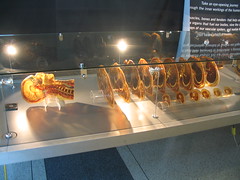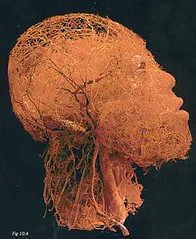Body Worlds-When science met art
Among the many super-duper-neato things I did over the weekend in the Windy City, I checked out the Body Worlds exhibit at the Museum of Science and Industry in South Chicago. For those not familiar with this exhibit, a little history: Gunther von Hagens finished his medical studies in West Germany in the mid-70’s after a tumultuous few years in Communist East Germany.  After practicing medicine for a few years, he invented the plastination technique which enabled the cessation of body decay by replacing water and fats in a dead body with polymers. This dearth of water denied destructive microorganisms the environment they need in order to colonize and eat away at dead flesh.
After practicing medicine for a few years, he invented the plastination technique which enabled the cessation of body decay by replacing water and fats in a dead body with polymers. This dearth of water denied destructive microorganisms the environment they need in order to colonize and eat away at dead flesh.
Armed with this powerful ability to maintain the presentation of a body, von Hagens eventually decided to put together an exhibit exploring the wonders of the human body. Hence, Body Worlds. Educational in nature, the exhibit explores each major functioning unit in the body (muscular system, skeletal system, digestive system, nerve system, etc.) by using the bodies of donors (people bequeath their bodies upon death) dissected and segmented in various ways. Sometimes you’re looking at an isolated organ, other times your looking at a body in a running pose with all the skin stripped away to enhance the effect of muscles in motion. Although the entire exhibit captivated my interest, von Hagens’ work with the human circulatory system has to be one of the most astounding things I’ve ever witnessed. The handlers injected a red polymer dye into the blood vessels of chosen donors until the corpses’ entire network of vessels was glutted with the solution. Once dry, this polymer hardened and maintained its shape. Next, a combination of chemicals and ultrasound dissolved the overlying tissue and bone, while leaving the polymer-filled circulatory system completely intact. When finished, a surreal 3-dimensional representation of the human form remained that showcased places where vessel networks exist and nerve ends concentrate (i.e. lips and eyelids). The example shown at left offers some idea of the beautiful resulting cast. It made you look at the human body in a whole new way.
Although the entire exhibit captivated my interest, von Hagens’ work with the human circulatory system has to be one of the most astounding things I’ve ever witnessed. The handlers injected a red polymer dye into the blood vessels of chosen donors until the corpses’ entire network of vessels was glutted with the solution. Once dry, this polymer hardened and maintained its shape. Next, a combination of chemicals and ultrasound dissolved the overlying tissue and bone, while leaving the polymer-filled circulatory system completely intact. When finished, a surreal 3-dimensional representation of the human form remained that showcased places where vessel networks exist and nerve ends concentrate (i.e. lips and eyelids). The example shown at left offers some idea of the beautiful resulting cast. It made you look at the human body in a whole new way.
I highly encourage anyone passing through Philadelphia (October 7-April 23, 2006) or Toronto (September 30-February 26, 2006; Body Worlds 2…it’s actually in Cleveland until September 18th) to take a couple hours and find out what cirrhosis of the liver looks like.


2 comments:
i saw the same exhibit last month and it was fascinating. love that kind of stuff.
nice. i can't wait until it comes to philly because i want to go again.
Post a Comment